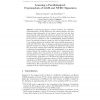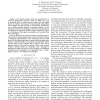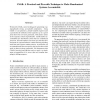318 search results - page 17 / 64 » How to Leak a Secret |
ACNS
2003
Springer
14 years 26 days ago
2003
Springer
Key exposures, known or inconspicuous, are a real security threat. Recovery mechanisms from such exposures are required. For digital signatures such a recovery should ideally —an...
ESORICS
2002
Springer
14 years 7 months ago
2002
Springer
It is believed that masking is an effective countermeasure against power analysis attacks: before a certain operation involving a key is performed in a cryptographic chip, the inpu...
EUROCRYPT
2006
Springer
13 years 11 months ago
2006
Springer
Abstract. Lattice-based signature schemes following the GoldreichGoldwasser-Halevi (GGH) design have the unusual property that each signature leaks information on the signer's...
CORR
2010
Springer
13 years 6 months ago
2010
Springer
— We consider perfect secret key generation for a “pairwise independent network” model in which every pair of terminals share a random binary string, with the strings shared ...
NDSS
2009
IEEE
14 years 2 months ago
2009
IEEE
We describe CSAR, a novel technique for generating cryptographically strong, accountable randomness. Using CSAR, we can generate a pseudo-random sequence and a proof that the elem...



